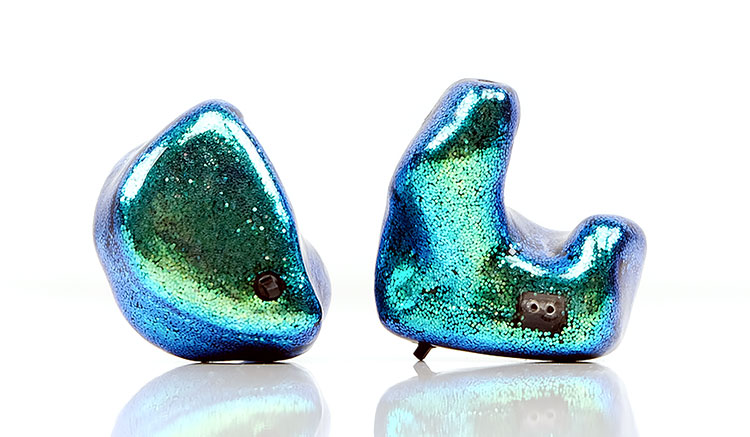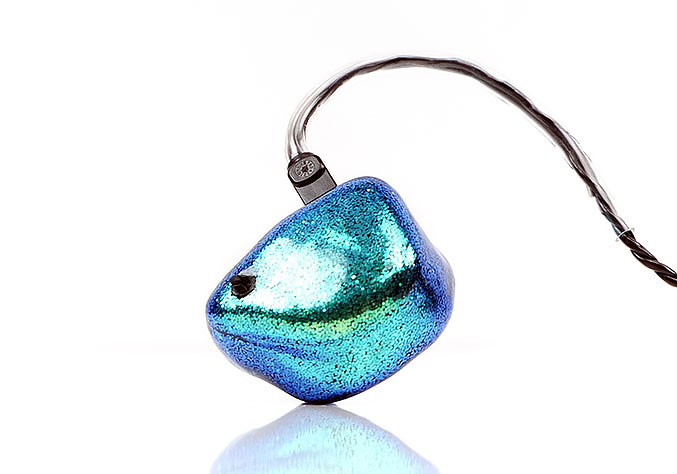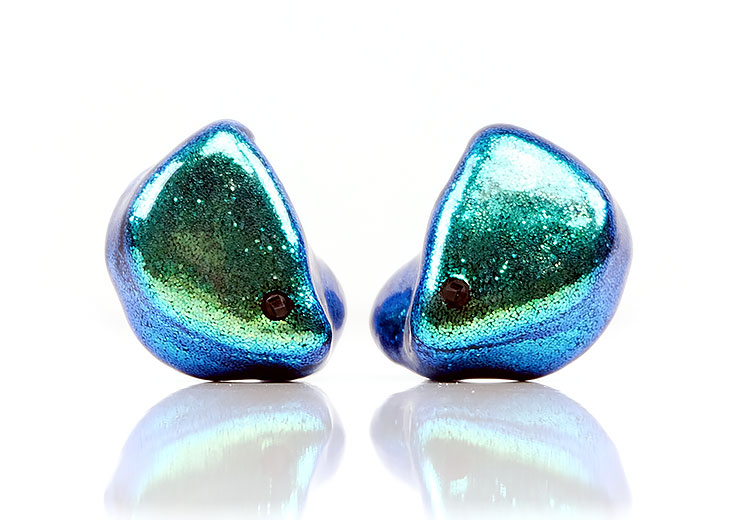Meet The Aether R
Design
The Scarabeus design is very unique to my eyes and the closer you look at it the more revealing it becomes in terms of minute detail. Lime Ears has used a specially processed opalizing glitter over a hollow-body acrylic shell and faceplate to build a continuous design form with very subtle color shades.
The dominant color from the pics would seem to be a few varieties of blue interrupted by the pure black bass switch on the front faceplate but I can tell you this.
Whichever way you move it, when it catches the light you will see the green turn to blue. It is an awesome two-tone design to be perfectly honest.
Finishing
The finish is a very high gloss to achieve that shimmer under certain lighting conditions so the choice to put on individualized artwork or even logos does not work for me. You need the finish to be as clean as possible to get the reflective effective optimal.
To that effect, Lime Ears has been rather discreet with the number coding on the underside and no logos on the front.
VariBore Nozzle
You may not be able to see enough from the picture but the nozzle on the Aether R is a tri-bore design using their VariBore technology rather than a horn construction more typical of Vision Ears and Empire Ears.
As mentioned in our technology discussion on page 1 the bores are all different in diameter to maximize the individual frequency response groups. This means each bore opening at the tip of the nozzle has a different diameter.
In the case of the Aether, you have one more opening roughly twice the size of the two smaller ones which look to me about the same size as each other.
The bores also go right to the tip of the nozzle so I do advise giving them a quick clean after each use to prevent any wax or dirt from creeping in and blocking the tubes.
Stock Cable
The stock cable seems like a typical 4-wire OFC Plastics One-type unbalanced build. It’s 1.2mm in length, has low microphonics, and light, and is pliant. There is some memory hook material near the 2-pin connectors that is easy enough to bend and shape for wearing over your ear.
That being said, cable rollers will enjoy working with the Aether R. The stock cable does contribute a lot to that relaxed natural but warm sound but compared to less resistive cables the stock option leaves the presentation a little more compressed than I would prefer.
Aftermarket Options
Of course, a new aftermarket cable is more costs but cables like the Ares II from Effect Audio at $150 and the excellent Satin Audio Medusa pure silver at $209 do provide a perceptible improvement in dynamic range, loudness, and resolution.
My own personal favorite that is easy on the wallet is the OC Studio Orpheus MK5 8-wire at $250. This is a phenomenal cable for teasing out the low-end texture, a little more treble presence, and enhancing the openness in the Aether R’s soundstage.
Comfort & Fit
This is a top-notch seal with an accurate fit but one that focuses a little more on how stage artists like it. That means that fantastic seal comes from a touch more ear canal pressure than some of the more relaxed fittings I have had.
It seems to be one of those things. If you want an amazing seal and excellent isolation you get this type of fit. Empire Ears and JH Audio seem to also fall into this category based on my experience with their customs.
If you want something purely for comfort then you lose a little bit of seal or add a huge length to the end nozzle and seal a bit deeper. AAW and Unique Melody are good examples of a relaxed fit.
Physically, I do not feel the Aether R stick out of my ear too much and the bass switch is positioned to the base which makes it easy to use without interfering too much with the driver shells and creating unnecessary noise or breaking the seal.
Sound Impressions
Summary
Unless you are a complete treblehead or a dynamic driver purist it is incredibly hard not to enjoy the Aether R’s sound signature. Call me enamored if you will but I for one enjoyed its tuning with all the ‘bumps’ in the right places to produce a riotously musical and slightly euphonic listening experience.
When I say musical, it tends to mean a lot of things to a lot of people, but for me, it is a pleasant ‘driving sound’ with good PraT, heady vocal prominence, and a smooth full-bodied treble.
In a way, it sort of reminds me of the excellent qdc Anole V6 tuning with a ‘spot on’ wet timbre tuned for an involved yet non-fatiguing listening experience.
To that extent, the Aether R more than meets this criterion with an FR that sort of follows a M/U-shaped curve with some pleasing mid-bass warmth, forward and big sounding mids, and a treble that has a rising presence but doesn’t intrude with a peak around 7-8k that doesn’t outpace that mid-range focus.
And then there is the bass boost switch. With it off, read the above, with it switched on, read the above again and add around 2-3dB to the mid-bass and midrange elevation.
It is not enough to break the cover and go basshead quite like the Model X’s 8dB boost. It still sounds like an ‘Aether R’ just a slight bit more bloom and weight down below as well as a slightly more prominent vocal with a richer timbre to go with it.
Example
It is subtle but with neutral sources, I enjoy the effect, and works well with fat bass and synth track such as Dan Reed Network’s classic funk metal “Ritual” from the late ’80s.
The driving bass guitar and synth accompaniment give this song some serious toe-tapping life. With the bass switch off it sounds too reserved, too neutral, and flat. With the switch on the additional body fills out the low-end and lower-mid instrumental body and in turn, back comes the PRaT essential for this track to work.
Staging
The cards are not hugely stacked on the low end of the Aether R. It has good depth and presence so I would not call it a flat neutral bass performance but neither is it a gut-wrenching powerhouse ala Campfire Audio Atlas and its huge dynamic driver tuning.
The focus is a little more on 50-100Hz and a mid-bass lift and a reasonably gentle cut into the lower mids so instrumental positioning is not that recessed with decent space and above-average imaging.
That mids 1-3k bump does push all but the most guttural of vocals forward skewing the staging a little from front to back. Combined with a 4-5k scoop, vocals on the Aether R rarely sound drowned out by any percussion energy or hard-hitting synth bass.
Air and headroom are just ok for me, nothing swirly or ethereal sounding. There is a bump in the upper treble that prevents the Aether R from sounding dark and shelved down but it’s still on the relaxed side comparatively speaking to the likes of the Andromeda.
Bass
This is one of the key areas of the Aether R with its bass boost option. On the Model X, Lime Ears went for it with a strong 8dB rise that turned its otherwise neutral bass into a V-shaped explosion.
The Aether R doesn’t quite have that aggression with its bass boost much lower at around 3-4dB. The core signature of the Aether R remains identifiable throughout.
However, the non-boosted low-end of the Aether R is not as neutral to my ear and delivers a bit more warmth and body than the Model X’s stock tuning. The sub-bass is not hugely prominent in the stock-off position with more of a polite mid-bass rise from 50-100Hz and a smooth linear drop into the lower mids around 700-800Hz.
More often than not I found myself switching on the bass boost, especially for R’n’B and synth-wave tracks.
The nuanced smaller dB increase fills the staging a lot better without becoming overpowering and adds some necessary weight to instruments pitching low and need to sound fairly planted.
Mids
Mids on the Aether R have a pronounced bump that starts way down around 800Hz and doesn’t drop off until around 3k. It is by far the most prominent aspect of the FR tuning of the Aether R so vocal lovers, especially female vocal lovers will lap the performance up.
They are not skewed unnaturally like the older niche Vision Ears VE5, they are not shrill or shouty per se, but they are forward and more intimate sounding, especially with a 4-6k dip that tends to pull back on any potential splashiness from percussion pushing down on vocals.
That is the one caveat of the Ather R, that 4-6k dip. Those who like their percussion with bite might not find it on the Aether R.
The timbre throughout is natural-sounding, with more than a hint of euphony and a slight sweetness that makes it a deft choice for the anti-sibilance crowd. However, it is not a rounded romantic lush signature.
There is enough upper treble odd-harmonic presence to keep it from sounding smoothed over and lacking in detail. Veiled the Aether R is not.
What I love most is the ability for the bass boost switch to also deliver a slightly stronger vocal. It is not just the low end that gets a little boost. That Fletcher-Munson principle does mean vocals get a little more presence and focus without becoming detached and unbalanced sounding. Love it!
Treble
Despite the Aether R having a decent bit of upper treble elevation around 7-8k it’s not dominant nor does it out-gun that mid-bass bump. It is a fairly relaxed curve, to be honest, and that elevation is more about offering a bit more headroom and air to allow vocal and percussion to breathe.
The lack of amplitude, (dB) at 4-6k sliding into the lower treble means percussion presence is not overpowering but it is accurate enough to pull enough odd-harmonic overtones from the upper treble elevation.
You are unlikely to hear any splashiness or sibilance in the Aether R tuning. It is wet enough and smooth enough to prevent any sharp nasties from creeping in can make it a very pleasurable listening experience.
Click on page 3 below for Matchability & Select Comparisons









